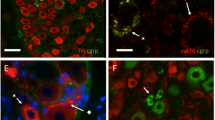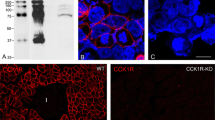Summary
Inguinal hernia is the most common congenital disease in paediatrie surgery. It is apparent that inguinal hernias result from a patent processus vaginalis (PV). However, it remains unclear how the PV closes in normal development. It is proposed that calcitonin gene-related peptide (CGRP) released from the genitofemoral nerve acts on the PV and causes fusion. The aims of this study are to determine whether there are CGRP containing nerve fibres and CGRP receptors in the PV. Immunoreactivity for CGRP was studied in wholemount preparations and frozen sections used for receptor studies. In all 13 PV specimens CGRP-immunoreactive nerve fibres were detected and these nerve fibres were located in the mesenchyme of the PV. A [125I] radiological binding assay was performed in 12 hernial sacs to demonstrate the presence of CGRP receptors. Seven of 12 hernial sacs showed specific binding by computerized densitometry in the mesenchyme adjacent to the lining epithelium of the PV. Specific binding ranged from 0.95% to 59.6% of total binding (mean 22.75). Emulsion autoradiography showed [125I] labelled CGRP binding to blood vessels and mesenchyme fibroblasts. These findings are consistent with CGRP being released from nerve fibres and binding to CGRP binding sites in the hernial sac.
Similar content being viewed by others
References
Brain SD, Williams TJ, Tippins JR et al (1984) Calcitonin gene-related peptide is a potent vasodilator. Nature 313: 54–56.
Breimer LH, MacIntyre I, Zaidi M (1988) Peptides from the calcitonin genes: molecular genetics, structure and function. Biochem J 225: 377–390
Clarnette TD, Hutson JM (1996) The genitofemoral nerve may link testicular inguinoscrotal descent with congenital inguinal hernia. Aust NZ J Surg 66: 612–617
Clarnette TD, Hutson JM (1997) Is the ascending testis actually ‘stationary’? Normal elongation of the spermatic cord is prevented by a fibrous remnant of the processus vaginalis. Pediatr Surg Int 12: 155–7
Clarnette TD, Hutson JM (1999) The development and closure of the processus vaginalis. Hernia 3: 97–102
Hutson JM, Albano FR, Paxton G, et al (in press) In vitro fusion of human inguinal hernia with associated epithelial transformation. Cells Tissues Organs
Hutson JM, Hasthorpe S, Heyns CF (1996) Anatomical and functional aspects of testicular descent and cryptorchidism. Endocr Rev 18: 259–280
Hutson JM, Watts LM, Farmer PJ (1998) Congenital undescended testes in neonatal pigs and the effect of exogenous calcitonin generelated peptide. J Urol 159(3): 1025–8
Rosenfeld MG, Mermod JJ, Amara SG, et al (1983) Production of a novel neuropeptide encoded by the calcitonin gene-related peptide encoded by the calcitonin gene via tissue-specific RNA processing. Nature 304: 129–135
Samarakkody UK, Hutson JM (1992) Intrascrotal CGRP 8-37 causes a delay in testicular descent in mice. J Pediatr Surg 27: 874–875
Schwindt B, Farmer PJ, Watts LM, Hrabovszky Z, Hutson JM (1999) Localization of calcitonin gene-related peptide (CGRP) within the genitofemoral neve (GFN) in immature rats. J Pediatr Surg 34: 986–991
Taché Y, Holzer P, Rosenfeld MG (1992) Calcitonin gene-related peptide. The New York Academy of Sciences, New York
Tayakkanonta K (1963) The gubernaculum and its nerve supply. Aust NZ J Surg 33: 61–67
Weber TR, Tracy JTF (1993) Groin hernias and hydroceles. In: Ashcraft KW, Holder TM (eds) Pediatrie Surgery. 2nd ed. Philadelphia: WB Saunders, pp 562–570
Yamanaka J, Metcalfe SA, Hutson JM (1992) Demonstration of calcitonin gene-related peptide receptors in the gubernaculum by computerized densitometry. J Pediatr Surg 27: 876–878
Yamanaka J, Metcalfe SA, Hutson JM, et al (1993) Testicular descent II. Ontogeny and response to denervation of calcitonin generelated peptide receptors in neonatal rat gubernaculum. Endocrinology 132: 1–5
Author information
Authors and Affiliations
Rights and permissions
About this article
Cite this article
Sugita, Y., Uemura, S., Hasthorpe, S. et al. Calcitonin gene-related peptide (CGRP)-immunoreactive nerve fibres and receptors in the human processus vaginalis. Hernia 3, 113–116 (1999). https://doi.org/10.1007/BF01195307
Received:
Accepted:
Issue Date:
DOI: https://doi.org/10.1007/BF01195307




